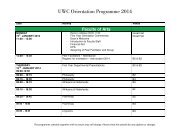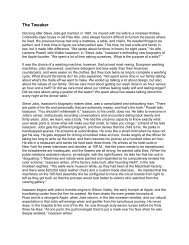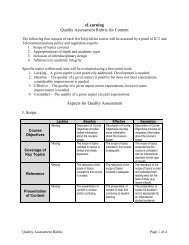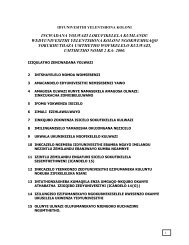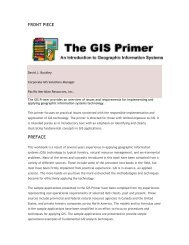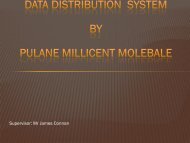Ecosystem Guidelines for Environmental Assessment
Ecosystem Guidelines for Environmental Assessment
Ecosystem Guidelines for Environmental Assessment
Create successful ePaper yourself
Turn your PDF publications into a flip-book with our unique Google optimized e-Paper software.
SUCCULENT KAROO<br />
Quarrying <strong>for</strong> granite ("dimension stone") is an increasing problem in the granite areas of Garies,<br />
Bitterfontein, Springbok and Pofadder, as is quarrying <strong>for</strong> gravel in the Saldanha Bay area. Climate<br />
change may have a substantial negative effect on many of the localised endemics.<br />
Certain succulent species are threatened by illegal collection.<br />
A proliferation of game fences in some areas may threaten faunal migration.<br />
What are the “bottom lines” and non-negotiables<br />
Physical disturbance of the vegetation should be limited to the minimum as most Succulent Karoo<br />
plant communities recover very slowly, if at all, after heavy grazing or other pressures.<br />
Grazing by domestic stock and game species should follow recommendations of the Department of<br />
Agriculture and CapeNature.<br />
Abstraction of ground and surface water should be controlled and carefully monitored.<br />
All concentrations of rare and endemic plant species should be considered as "no go" areas <strong>for</strong><br />
development. No viable populations of such species should be lost to development.<br />
What broad spatial guidelines can be given with respect to<br />
the best approach to development and disturbance<br />
Avoid all rocky outcrops, especially by mining or quarrying.<br />
Avoid quartz patches and ridges, particularly those regarded as being acidic.<br />
Avoid impacting on any wetland areas or riverine fringes.<br />
Limit development to disturbed environments such as old lands and heavily overgrazed sites.<br />
What are the critical things to maintain in terms of managing these<br />
systems <strong>for</strong> biodiversity, and ensuring its persistence<br />
Avoid disturbance to the biogenic crust and special habitats such as quartz patches. Generally<br />
minimise disturbance to natural vegetation.<br />
Prevent soil erosion as windblown sediments can smother sensitive areas such as quartz patches<br />
and small rocky outcrops. Retain indigenous fauna and their migration corridors.<br />
Retain natural vegetation in floodplains.<br />
The presence of rare and endemic species that are reproducing.<br />
(left) Avoid disturbing special habitats such as quartz patches and ridges as they cannot be rehabilitated once disturbed.<br />
(right) Rare species are often associated with specific habitats, such as the quartz patches of the Knersvlakte<br />
– a Succulent Karoo “hotspot”.<br />
ANTON WOLFAARDT<br />
ANTON WOLFAARDT<br />
60 : SUCCULENT KAROO ECOSYSTEMS



